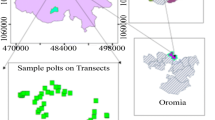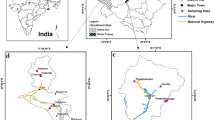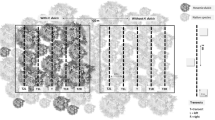Abstract
Both natural and anthropogenic disturbances are key drivers of forest dynamics that alter species composition and diversity, which in turn determine the successional trajectory of the forests. The present study aimed to investigate the community composition, population structure and regeneration status of tree species in relation to anthropogenic disturbances in temperate pure coniferous forests of Kashmir Himalaya. Comparable forest sites with varying degree of disturbance were selected and the regeneration status of the tree species was determined by measuring the population size of seedlings and saplings. The seedling, sapling and tree density were significantly greater in the less disturbed (LD) sites as compared to the highly disturbed sites (HD). Moreover, the LD sites showed highest frequency of lower tree girth classes, resulting in the formation of an inverse J-shaped curve, while as the HD sites showed unimodal distribution with maximum number of individuals in higher girth classes. Such a shift in forest structure from inverse J-shaped to unimodal distribution alters the niche space and facilitates the colonization of non-resident oak species (Quercus baloot, Q. incana), which otherwise are component of relatively low-altitude mixed temperate forests of the region. The results of the present study provide baseline ecological indicators in characterizing and quantifying the human-driven changes in forest composition and structure; and can help in developing scientifically-informed policy tools for the effective management and ecological restoration of human-modified forest landscapes in this Himalayan region.






Similar content being viewed by others
References
Adamowski W, Dvorak I, Ramanjuk I (2002) Atlas of alien woody species of the Białowieza forest. Phytocoenosis 14:1–303
Ahmed M, Hussain T, Sheikh AH, Hussain SS, Siddiqui MF (2006) Phytosociology and structure of Himalayan forests from different climatic zones of Pakistan. Pak J Bot 38:361–383
Bhat JA, Negi AK, Todaria NP (2015) Regeneration status of woody species in a protected area of Western Himalaya. Acta Ecol Sin 35:51–58
Bhuyan P, Khan ML, Tripathi RS (2003) Tree diversity and population structure in undisturbed and human-impacted stands of tropical wet evergreen forest in Arunachal Pradesh, Eastern Himalayas. India. Biodivers Conserv 12:1753–1773
Chakraborty A, Saha S, Sachdeva K, Joshi PK (2018) Vulnerability of forests in the Himalayan region to climate change impacts and anthropogenic disturbances: a systematic review. Reg Environ Change 18:1783–1799
Chazdon RL, Bodin B, Guarig-uata M, Lamb D, Walder B, Chok-kalingam U, Shono K (2017) Partnering with nature: the case for natural regeneration in for-est and landscape restoration. FERI Policy Brief, Montreal
Crandall RM, Knight TM (2018) Role of multiple invasion mechanisms and their interaction in regulating the population dynamics of an exotic tree. J Appl Ecol 55:885–894
Curtis JT, McIntosh RP (1951) The interrelations of certain analytic and synthetic phytosociological characters. Ecology 31:434–455
Dar GH, Khuroo AA (2013) Floristic diversity in the Kashmir Himalaya: progress, problem and prospects. Sains Malays 42:1368–1377
Eilu G, Obua J (2005) Tree condition and natural regeneration in disturbed sites of Bwindi Impenetrable Forest National Park, southwestern Uganda. J Trop Ecol 46:99–101
Forest Survey of India, Ministry of Environment and Forests. Govt. of India. FSI (2017) State of forest report. Dehradun, India
Gairola S, Sharma CM, Ghildiyal SK, Suyal S (2012) Regeneration dynamics of dominant tree species along an altitudinal gradient in moist temperate valley slopes of the Garhwal Himalaya. J For Res 23:53–63
Ghazoul J, Sheil D (2010) Tropical rain forest ecology, diversity, and conservation. Oxford University Press, Oxford
Ghildiyal S, Baduni NP, Khanduri VP (1998) Community structure and composition of oak forests along altitudinal gradient in Garhwal Himalaya. Indian For Res 21:242–247
Ghimire B, Mainali KP, Lekhak HD, Chaudhary RP, Ghimeray AK (2010) Regeneration of Pinus wallichiana AB Jackson in a Trans Himalayan dry valley of north-central Nepal. Himal J 6:19–26
Głowacki D, Sławska M, Sławski M (2016) The dynamics of northern red oak (Quercus rubra L.) in managed forests of central Poland. For Res Pap 77:32–41
Good NF, Good RE (1972) Population dynamics of tree seedlings and saplings in mature Eastern hardwood forest. Bull Torrey Bot Club 99:172–178
Haugaasen T, Barlow J, Peres CA (2003) Surface wildfires in central Amazonia: short-term impact on forest structure and carbon loss. For Ecol Manag 179:321–331
Henle K, Saree S, Wiegand V (2004) The role of density regulation in extinction processes and population viability analysis. Biol Conserv 13:9–52
Hirschmugl M, Gallaun H, Dees M, Datta P, Deutscher J, Koutsias N, Schardt M (2017) Methods for mapping forest disturbance and degradation from optical earth observation data: a review. Curr For Rep 3:32–45
Husain SS (2001) Geography of Jammu and Kashmir. Rajesh Publications, New Delhi
Jones RH, Sharitz RR, Dixon PM (1994) Woody plant regeneration in four flood plants forests. Ecol Monogr 64:345–367
Kaur H, Gupta S, Parkash S (2017) Comparative evaluation of various approaches for landslide hazard zoning: a critical review in Indian perspectives. Curr Sci 25:389–398
Khan ML, Rai JPN, Tripathi RS (1987) Population structure of some tree species in disturbed and protected sub-tropical forests of North East India. Acta Oecol 8:247–255
Kharkwal G (2009) Qualitative analysis of tree species in evergreen forests of Kumaun Himalaya, Uttarakhand, India. Afr J Plant Sci 3:49–52
Khumbongmayum AD, Khan ML, Tripathi RS (2006) Biodiversity conservation in sacred groves of Manipur, northeast India: population structure and regeneration status of woody species. Biodivers Conserv 15:2439–2456
Kimmins JP (1987) Forest ecology. Macmillan Publishing Company, New York
Kumar A, Ram J (2005) Anthropogenic disturbances and plant biodiversity in forests of Uttaranchal, Central Himalaya. Biodivers Conserv 14:309–331
Major KC, Nosko P, Kuehne C, Campbell D, Bauhus J (2013) Regeneration dynamics of non-native northern red oak (Quercus rubra L.) populations as influenced by environmental factors: a case study in managed hardwood forests of south- western Germany. For Ecol Manag 291:144–153
Malik ZA, Bhatt AB (2015) Phytosociological analysis of woody species in Kedarnath Wildlife Sanctuary and its adjoining areas in Western Himalaya, India. J For Ecol 31:149–163
Malik ZA, Bhatt AB (2016) Regeneration status of tree species and survival of their seedlings in Kedarnath Wildlife Sanctuary and its adjoining areas in Western Himalaya, India. Trop Ecol 57(4):677–690
Malik ZA, Hussain A, Iqbal K, Bhatt AB (2014) Species richness and diversity along the disturbance gradient in Kedarnath Wildlife Sanctuary and its adjoining areas in Garhwal Himalaya, India. Int J Curr Res 6:10918–10926
Malik ZA, Pandey R, Bhatt AB (2016) Anthropogenic disturbances and their impact on vegetation in Western Himalaya, India. J Meteorol Sci 13:69–82
Marcilio-Silva V, Pillar VD, Marques MCM (2016) Functional turnover and community assemblage during tropical forest succession. Commun Ecol 17:88–97
Mehraj G, Khuroo AA, Qureshi S, Muzafar I, Friedman RC, Rashid I (2018) Patterns of alien plant diversity in the urban landscapes of global biodiversity hotspots: a case study from the Himalayas. Biodivers Conserv 27:1055–1072
Millar IC, Stephenson LN (2015) Temperate forest health in an era of emerging mega disturbance. Science 349:823–826
Naidu TM, Kumar AO (2016) Tree diversity, stands structure, and community composition of tropical forests in Eastern Ghats of Andhra Pradesh, India. J Asia Pac Biodivers 9:328–334
Nautiyal N, Schmerbeck J (2017) The changing Himalayan landscape: pine-oak forest dynamics and the supply of ecosystem services. J For Res 28:431–443
Pant S, Samant SS (2007) Assessment of plant diversity and prioritization of communities for conservation in Mornaula Reserve forest. Appl Ecol Environ Res 5:123–138
Rakthi D, Kenyusen K, Khumbongmayum AD, Paul A, Khan ML (2005) Population structure and regeneration status of medicinal tree Illicium griffithii in relation to disturbance gradients in temperate broad-leaved forest of Arunachal Pradesh. Curr Sci 89:673–676
Rawat DS, Dash SS, Sinha BP, Kumar V, Banerjee A, Singh P (2018) Community structure and regeneration status of tree species in Eastern Himalaya: a case study from Neora Valley National Park, West Bengal, India. Taiwania 63:16–24
Riepsas E, Straigyte L (2008) Invasiveness and ecological effects of red oak (Quercus rubra l.) in Lithuanian forests. Baltic For 14:122–130
Saikia P, Khan ML (2013) Population structure and regeneration status of Aquilaria malaccensis Lam. in home gardens of Upper Assam, northeast India. J Trop Ecol 54:1–13
Saxena AK, Singh JS (1984) Tree population structure of certain Himalayan forest associations and implications concerning their future composition. Vegetation 58:61–69
Shaheen H, Ullah Z, Khan MS, Harper MD (2012) Species composition and community structure of western Himalayan moist temperate forests in Kashmir. For Ecol Manag 278:138–145
Shaheen H, Malik NM, Dar M (2015) Species composition and community structure of Sub tropical Forest Stands in Western Himalayan Foothills of Kashmir. Pak J Bot 47:2151–2160
Shrestha BB, Ghimire B, Lekhak HD, Jha PK (2007) Regeneration of tree line birch (Betula utilis D. Don) forest in a Trans-Himalayan dry valley in central Nepal. Mt Res Dev 27:259–267
Siddiqui MF, Ahmed A, Wahab M, Khan N, Khan MU, Nazim K, Hussain SS (2009) Phytosociology of Pinus roxburghii, Sargent (Chir Pine) in lesser Himalayan and Hindu Kush range of Pakistan. Pak J Bot 41:2357–2369
Singh SP, Singh JS (1992) Forests of the himalayas: structure, function and impact of man. Gyanodaya Prakashan, Nainital
Singh S, Malik ZA, Sharma CM (2016) Tree species richness, diversity, and regeneration status in different oak (Quercus spp.) dominated forests of Garhwal Himalaya, India. J Asia Pac Biodivers 9:293–300
Sundriyal RC, Sharma E, Rai LK, Rai SC (1994) Tree structure, regeneration and woody biomass removal in sub-tropical forest of Mamlay watershed in Sikkim Himalaya. Vegetatio 113:53–63
Tim S, Kueffer C, Rew LJ, Daehler C, Pauchard A, Naylor JB, Jake M (2012) Processes at multiple scales affect richness and similarity of non-native plant species in mountains around the world. Glob Ecol Biogeogr 21:236–246
Tripathi RS, Khan ML (2007) Regeneration dynamics of natural forests- a review. Proc Indian Acad Sci 73:167–195
Tripathi OP, Upadhaya K, Tripathi RS, Pandey HN (2010) Diversity, dominance and population structure of tree species along fragment-size gradient of a subtropical humid forest of Northeast India. Res J Environ Earth Sci 2:97–105
Uniyal P, Pokhriyal P, Dasgupta S (2010) Plant diversity in two forest types along the disturbance gradient in Dewalgarh Watershed, Garhwal Himalaya. Curr Sci 98:938–994
Verma RK, Kapoor KS, Subramani SP (2004) Evaluation of plant diversity and soil quality under plantation raised in surface mined areas. Indian For Res 27:227–233
Vor T (2005) Natural regeneration of Quercus rubra L. (Red oak) in Germany. NeoBiota 6:111–123
Wangda P, Ohsawa M (2006) Structure and regeneration dynamics of dominant tree species along altitudinal gradient in dry valley slopes of the Bhutan Himalaya. For Ecol Manag 230:136–150
Working Plan of Kehmil Forest Division (2017) Jammu and Kashmir Forest Department
Woziwoda B, Kopec D, Witkowski J (2014) The negative impact of intentionally introduced Qucercus rubra L. on a forest community. Acta Soc Bot Pol 83:39–40
Acknowledgements
We are thankful to the Head, Department of Botany, University of Kashmir, Srinagar, J&K for providing necessary facilities during the present study. Also, the helping hand rendered by the staff of Centre for Biodiversity and Taxonomy is highly acknowledged. Kind help provided by Mr. Maroof Hamid in statistical analysis is greatly acknowledged. Thanks are also due to the Principal Chief Conservator Forests, Govt. of Jammu and Kashmir, India for permission and support during field work in the study area.
Author information
Authors and Affiliations
Corresponding author
Rights and permissions
About this article
Cite this article
Haq, S.M., Rashid, I., Khuroo, A.A. et al. Anthropogenic disturbances alter community structure in the forests of Kashmir Himalaya. Trop Ecol 60, 6–15 (2019). https://doi.org/10.1007/s42965-019-00001-8
Received:
Revised:
Accepted:
Published:
Issue Date:
DOI: https://doi.org/10.1007/s42965-019-00001-8




